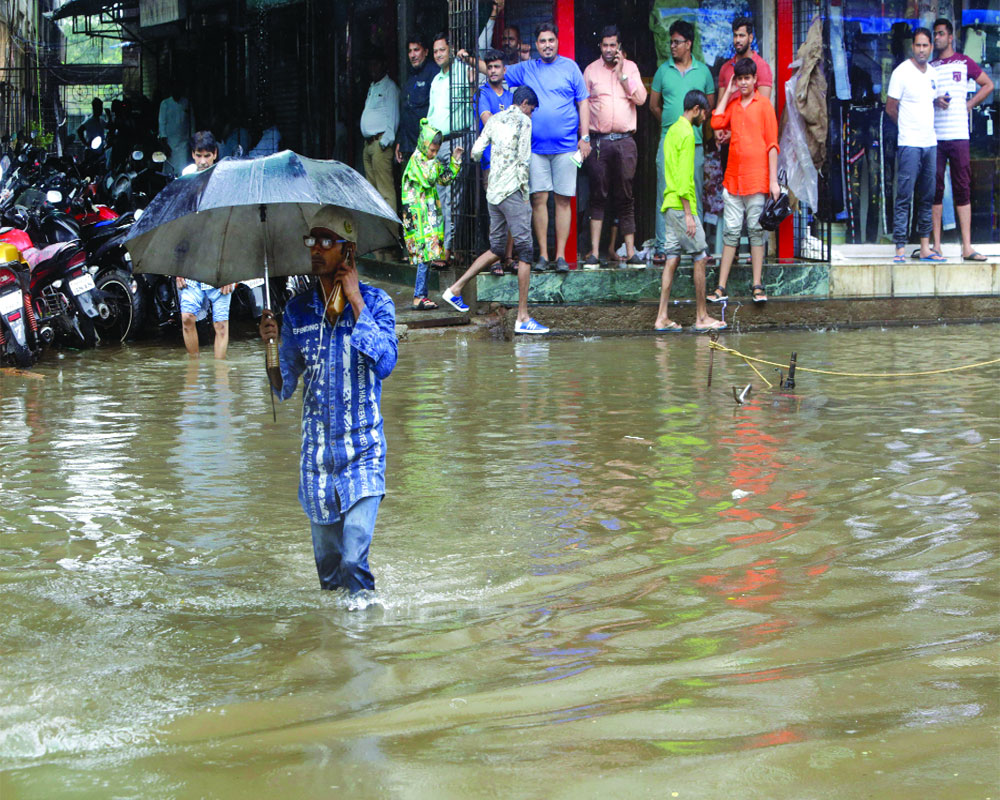Mud flats, wetlands, flood plains, mangroves and wooded vegetation once slowed down the flow of the storm water in the city. But these are non-existent now. Besides, the mud flats helped in retaining rainwater, letting it sink into aquifers
It’s that time of the year when Mumbaikars roll up their sleeves and take on the wrath of monsoon as their offices, homes, streets and even hospitals get inundated with flood water. The extent of water logging this year has been such that even departed souls have not been spared. Ambulances and hearse vans could not ferry the dead to the cremation ghats or cemeteries, owing to neck-deep water on the roads. This annual trial either by fire, or water in this case, is now part of the lives of denizens of Mumbai. No amount of year-round work seems to liberate the city dwellers from this retribution by mother nature.
At the time of writing this article, around 32 people were confirmed dead in the worst ever floods the financial capital of the nation experienced in the last decade. After the city went through nearly 16 inches of rain in the past few days, several parts of the booming metropolis became inundated in waist- deep water. This led to the local train and bus services being disrupted. Even schools and colleges were closed down as 50 flights were cancelled from the Mumbai airport.
The maximum city seems to be receiving a maximum dose of rain-related disasters annually. The pressing question is: Why is this scenario repeated year after year? The answer lies in the indiscriminate alteration done to the environment and ecology of the city and its surrounding regions.
The city’s ability to absorb monsoon rains has been weakened due to the construction boom that has destroyed much of its mangrove forests — trees that once helped drain the seasonal waters. Most flooded areas are near the banks of the city’s Mithi River, the 11-mile seasonal river that belongs to the wetlands where the trees once grew. Rising sea levels with the rain have also contributed to the flooding.
Of late, the city has also witnessed phenomenal overcrowding, which has led to immense loss of life in urban areas. Unprecedented and uncontrolled growth is the main cause for the booming population. This is the bane of most Indian cities, which are growing at an unprecedented rate. From a population of 2.86 million in 1950, Mumbai is now home to more than 21 million people and by 2030, it is expected to have a population of almost 28 million. Built along the coastline on a series of islands, the city is surrounded by water: In mudflats, lakes, creeks, rivers and the ever-present coastline. Given the astronomical land prices in many parts of the city as also the extreme scarcity of land, it is no surprise that Mumbai has sacrificed its ecology for development.
Real estate projects, industry and State infrastructure, including railways, roads and the airport, have built over and choked the city’s water networks at various strategic points. The result — every monsoon the city is flooded. Mudflats, wetlands, floodplains, mangroves and wooded vegetation once slowed down the flow of the storm water. But that is non-existent now, thus exposing the people to the raw end of nature’s fury.
The mangrove’s complex root systems and the branching architecture of trees acted as a natural barrier to reduce the force of water flow. But now, they are built over. Garbage clogs the waterways almost everywhere. Most channels and waterways that connect water bodies have been built over, too, thus preventing streams from easily reaching the sea — forcing them to spread out into low lying areas, adding to the severe flooding problem.
Mumbai’s extensive wetlands and mudflats, which had connected parts of the city since the early 19th century, are nowhere to be seen now. Their presence will retain rainwater and let it soak into the ground, recharging the wells and ground water table. Today, with nothing but concrete all around, the city’s land surface does not allow water to soak into it. Especially during intense periods of rain, devastation is extreme — at least 5,000 people are believed to have perished in the infamous floods of 2005 and the economic damage was estimated at 30 billion rupees ($690 million).
Sadly, neither the State Government nor the people have understood the severe cost they are paying each year even as the risks are building up. With virtually no bar on migration and no infrastructure support in place to handle the deluge of humanity flowing into Mumbai, the per square km population level is reaching unimaginable levels. So is the threat factor of lives being lost in case of a solid natural disaster. How will this spiralling situation get under control? The answer squarely lies in regulating the construction industry first.
Be it rainwater harvesting or eco friendly construction, the real estate sector of Mumbai is not known for either and therein lies the problem. For a city on the edge of an ecological apocalypse, the attitude is rather casual. This has to be discarded forthwith as nature is going through its cycle in a calculated manner and if the city does not want to get crushed under its inevitable weight, it better set the wrongs right and give due credit to the environment by taking care of it.
(The writer is an environmental journalist)


























